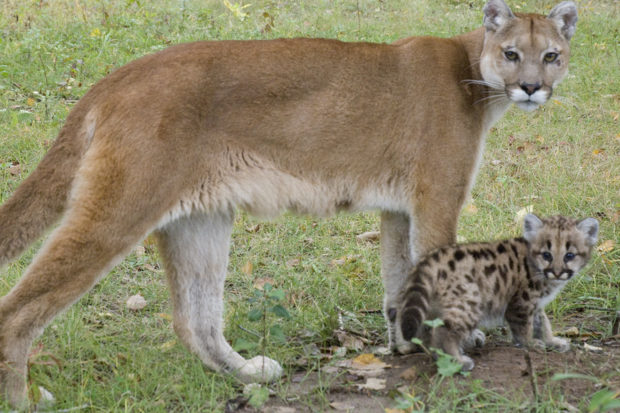This past Tuesday marked the resumption of an ugly, archaic chapter in the history of wildlife management in the West: New Mexico resumed a recreational trapping program for cougars, a practice that had been prohibited in the state for the last 40 years. New Mexico joins Texas as the only states to permit cougar trapping.
The cruelty inflicted by leg-hold traps and snares is well documented. When trapped, animals struggle fiercely to break free. They endure tremendous suffering, psychological distress, and severe injuries to their joints, tendons, and even their spines. They can suffer hypothermia or heat exhaustion. Trapped cougars, even tiny kittens, may die from dehydration, starvation, or predation.

A 2015 statewide poll found New Mexicans opposed cougar trapping and snaring by a three-to-one margin.
The HSUS, along with our partner Animal Protection of New Mexico and a group of New Mexico citizens concerned with the harm that trapping will have on cougars, filed a lawsuit challenging this recent rule change, which allowed steel-jawed leg-hold traps and snares to be set on more than nine million acres of state trust lands—including vast swaths of habitat shared with the critically endangered Mexican wolf and jaguar.
Our lawyers are making sure that cougars, jaguars, and wolves get their day in court, and that the state is held accountable for its rash and uninformed decision making. A 2015 statewide poll found New Mexicans opposed cougar trapping and snaring by a three-to-one margin. Yet, the New Mexico Game Commission, a governor-appointed (not elected) body, ignored the public’s wishes.
But even in states where cougar trapping is not specifically permitted, we’re still seeing incidental trapping. In Nevada, according to state inspectors, one in six cougars killed by trophy hunters showed damage to their claws, paws, and legs from traps and snares set out for bobcats. Not all survive, even after release; they are too damaged to hunt wild prey again. In the West, cougars in Idaho and Montana are victims to wolf traps.
Of the 16 remaining states with established cougar populations, California and Florida are the only ones to protect cougars from trophy hunters. The magnitude of trophy hunting America’s own lions is jaw-dropping. In the last 10 years, approximately 29,000 cougars have been killed by trophy hunters in the United States, according to a report we released earlier this year. But those are only the animals that wildlife managers know about. Never are the orphaned cougar kittens counted in this toll.
Most cougars will be chased by packs of trailing hounds wearing GPS collars, making the “hunt” a sort of high-tech search-and-destroy mission. Hounding poses significant risk to the hounds as well as to young wildlife, including dependent kittens, who may be attacked and killed by hounds. Hounds also disturb or kill non-target wildlife and trespass onto private lands. The practice is not fair chase and remains highly controversial even among hunters.
The HSUS works each day to protect cougars and other native carnivores from the seemingly endless persecution of trophy hunting. In 2016, we successfully helped stop efforts to allow cougar trapping in Wyoming. In 2015, we prevented the increase of cougar-hunting quotas to scientifically unsustainable levels in Washington and halted a wasteful and redundant “study” that would have culled cougars in Colorado in a vain attempt to inflate prey populations. But our work is never done.
State wildlife agencies compound the work of trophy hunters. Colorado Parks and Wildlife (CPW) proposed two egregious cougar- and bear-killing “studies.” They plan to cull up to 50 percent of their populations using both trophy hunters and wildlife services. They claim that with fewer predators, mule deer numbers will magically swell—so CPW can sell more deer tags. CPW wants to make a killing on all the killing. Yet even the agency’s own biologists have shown, over decades of research, that mule deer populations are limited because of human-caused factors. The real culprits in Colorado’s mule deer decline are oil and gas drilling, urban sprawl, climate change, and degradation of mule deer winter range. CPW’s proposed studies are merely predator-culling schemes designed to appease mule deer hunters and livestock owners.
Beautiful and elusive, cougars are apex predators in their native habitats. As we learn more about their familial nature and importance to their ecosystems, it’s no wonder so many Americans value them so highly. We’ll continue to fight for them, since there’s just no good reason to engage in the recreational killing of America’s lions.
The post America’s own Cecil problem appeared first on A Humane Nation.
Enviroshop is maintained by dedicated NetSys Interactive Inc. owners & employees who generously contribute their time to maintenance & editing, web design, custom programming, & website hosting for Enviroshop.
